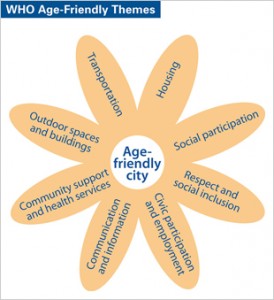AGE-FRIENDLY COMMUNITIES
Age-friendly communities strive to better meet the needs of their older residents by considering the environmental, economic, and social factors that influence the health and well-being of older adults. These programs seek to allow older adults to stay in their communities and “age in place.”
 The World Health Organization (WHO) supports a framework of “active aging” through age-friendly cities and towns. This framework looks at the determinants of active aging (e.g., social, economic, behavioral, personal, etc.) along with other age-friendly aspects of communities (e.g. transportation, housing, social participants, outdoor spaces, etc.). This graphic shows the eight WHO Age-Friendly Themes.
The World Health Organization (WHO) supports a framework of “active aging” through age-friendly cities and towns. This framework looks at the determinants of active aging (e.g., social, economic, behavioral, personal, etc.) along with other age-friendly aspects of communities (e.g. transportation, housing, social participants, outdoor spaces, etc.). This graphic shows the eight WHO Age-Friendly Themes.
Communities may consider several pathways to become more age-friendly, such a joining an age-friendly network or adopting evidence-informed models that support healthy aging across the lifespan. Each city or town may explore the approach that works best for its community.
One option is to join an age-friendly network. The WHO established a Global Network of Age-Friendly Cities and Communities to support communities who are taking active steps toward becoming more age-friendly. The AARP Network of Age-Friendly Communities is the U.S. affiliate of the WHO network. Brookline, Boston, and Yarmouth have been accepted into the WHO global network, and other communities are exploring applications.
